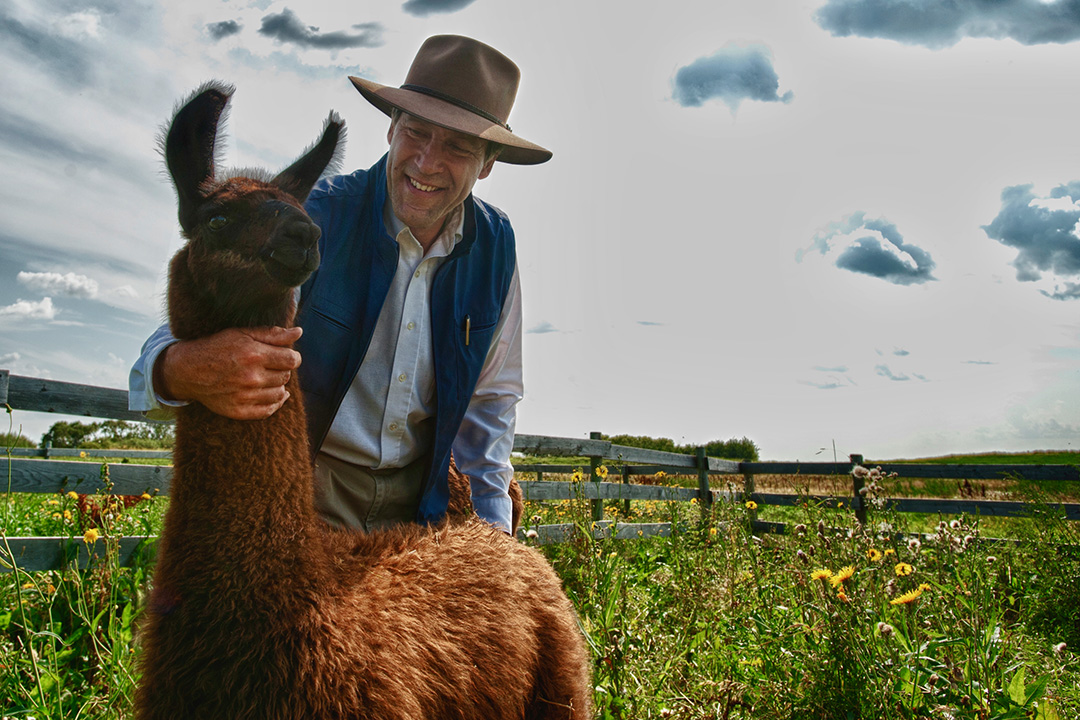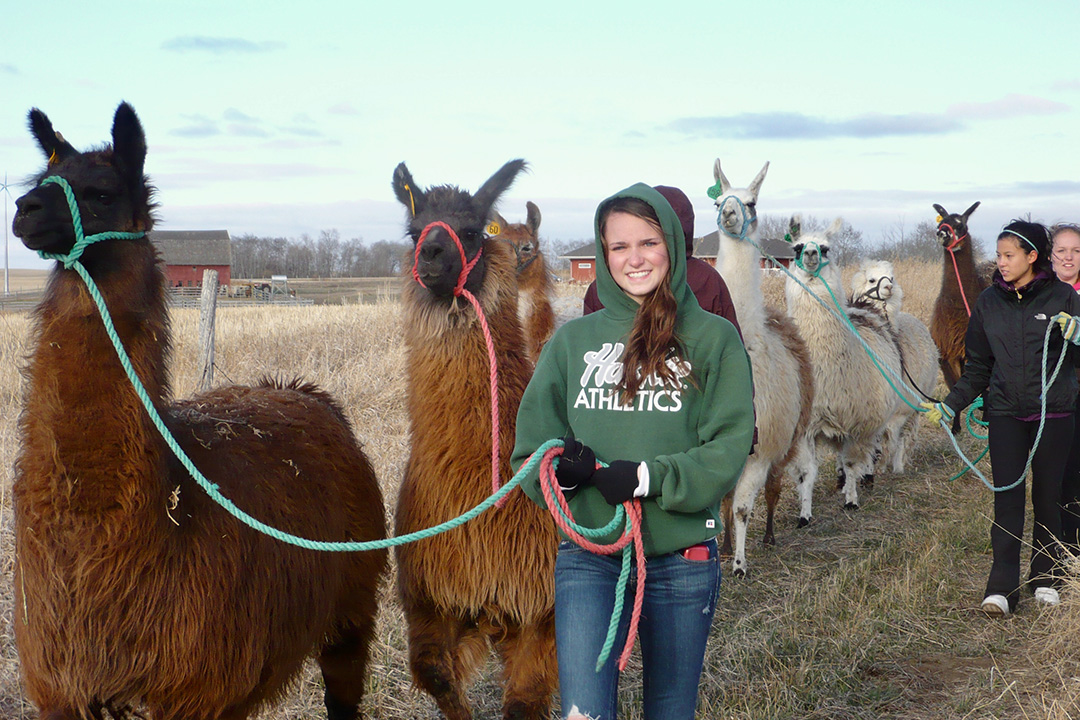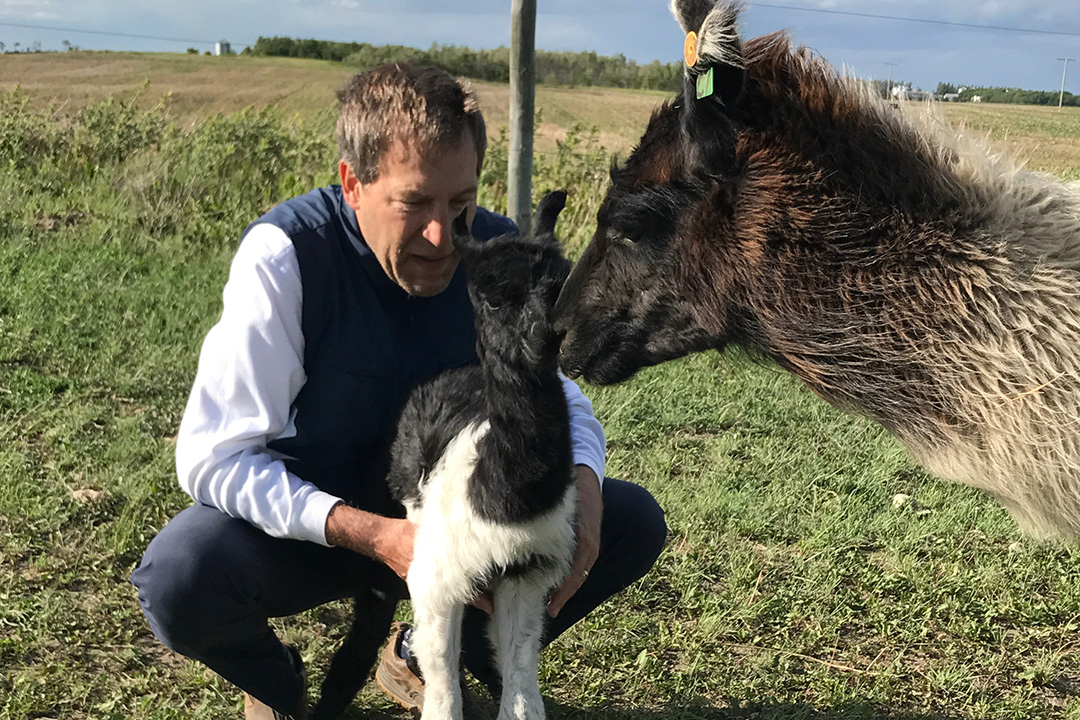
Camelids help USask researchers explore reproductive health mysteries in mammals
The United Nations has declared 2024 as the International Year of the Camelid in recognition of the animals’ contributions to maintaining healthy ecosystems around the world.
By Cat Zens
But for two University of Saskatchewan (USask) scientists, members of the Camelid family have earned their place in the spotlight for another reason: they’re fascinating models for reproductive research.
The Camelid family of species, which includes camels, guanacos, vicuñas, alpacas and llamas, are even-toed, ruminant mammals with three-chambered stomachs. These animals are a valuable source of milk, meat, wool and transportation for people throughout North Africa, South-West and Central Asia, Oceania and South America.
Camelids initially originated from North America, but they died out during the height of the last Ice Age, after survivors had migrated to South America (New World camelids) and Asia (Old World camelids). Thousands of years later, alpaca and llama populations are growing again in North America because of an increased interest in using their wool fibres for creating textiles. More people are also purchasing these camelid species as companion animals for humans, horses, sheep and other mammals.
“The camelids are back in North America to stay,” says Dr. Gregg Adams (DVM, PhD), a veterinarian and reproductive biology professor at the Western College of Veterinary Medicine (WCVM). “But how they will find their niche in the livestock economy versus companion animals remains to be seen.”

Besides their value as sources of wool fibre, meat and companionship, camelids are helping researchers learn more about reproduction in mammals — including humans. Adams and his WCVM colleague, Dr. Jaswant Singh (BVSc&AH, PhD), are part of the USask One Reproductive Health Group. Its members include a diverse group of scientists from veterinary medicine, human medicine, animal science, mathematics and other disciplines to better understand reproductive health in animals and people.
Adams and Singh have conducted numerous One Health studies related to reproductive health and are among a very small handful of scientists in Canada whose reproductive work includes llamas and alpacas. Camelids are unique reproductive research subjects because they’re considered “induced ovulators,” meaning that the females only ovulate (release eggs from their ovaries) in response to mating. In comparison, mammals such as dogs, cattle, horses and humans are categorized as “spontaneous ovulators” in which females ovulate at regular intervals regardless of mating.
Many smaller mammals, such as cats, rabbits, koalas, skunks and weasels are induced ovulators, but the evolution of this mechanism of ovulation remains a mystery. As the largest of species belonging to the induced ovulator category, the camelids’ size, their ease of handling and their availability combine to make them an ideal model for studying this biological phenomenon.
“It’s really just an interesting new model where I could actually understand the induced ovulating mechanism, which we didn’t understand very well [before],” Adams says.
Working with alpacas and llamas in Canada and South America, Adams and Singh have conducted numerous studies exploring the camelid’s role as an induced ovulator and its relationship to how females ovulate.

Their focus is ovarian follicles: these tiny sacs within the ovary contain the eggs and secrete hormones that influence fertility cycles in mammals. In camelids, Adams discovered that these follicles grow in a wave-like pattern within the ovaries. Adams and Singh then set out to understand why these patterns occur and how they could synchronize ovarian function so it can be easier to use reproductive technologies such as artificial insemination and embryo collection in camelids.
As they gained more insight about ovarian follicular patterns, the researchers discovered a chemical component in the semen of male camelids that affects the female camelid’s brain.
“We found out that a component of the semen gets absorbed through the uterus into the circulation and goes to the brain of the female and causes the release of hormones that are required for ovulation. The protein we found (nerve growth factor) is well conserved among species, and it's in the seminal plasma of all species including humans,” says Adams, whose recent research has focused on how this newly discovered function of semen actually works.
Since the researchers found high levels of NGF in the semen of every species examined, their conclusion is that the categories of spontaneous and induced ovulators are not as distinct as once thought. These observations raise new questions about how the ovarian cycle works and how it can be controlled — the “holy grail" for any scientist, veterinarian or human physician interested in fertility and contraception, says Adams.
Singh’s research focuses on controlling ovarian function using the alpaca as a research model. He’s the principal investigator of several research projects that examine if a specific hormone treatment will synchronize follicle dynamics and ovulation.
“We are looking at the ovarian effects of the drugs we develop,” Singh says. “How does this drug affect their ovarian function?”
Singh’s work on how reproductive drugs affect ovulation in camelids can help researchers learn more about reproductive therapies for humans and other mammals. As well, Singh points out that using induced ovulators such as alpacas and llamas as models for human reproductive studies is less complicated compared to spontaneous ovulating species. These studies have led to a recent patent for a treatment protocol that will enable scientists to synchronize ovarian function among a group or herd that will essentially enable “insemination by appointment” with a set ovulation date.
Research focused on camelids’ reproductive patterns has helped both Adams and Singh better understand the species’ health, and it has also benefited local alpaca and llama breeders.
“Our work has allowed us to apply clinical techniques and services to diagnose and treat [reproductive health] management problems in llamas and alpacas, and it has raised intriguing questions about whether the ovulation-inducing stimulus of semen is present in other species, including humans,” Adams says.
As the camelid population grows in North America, the two researchers hope to conduct more reproductive studies targeting alpacas and llamas that will help to build the knowledge base.
“We’re hoping to recruit a new faculty member who has interest in camelids to continue research on the mystery of the ovulation inducing factor [of reproduction],” says Adams. “We hope that our research program continues to flourish.”
Cat Zens of North Battleford, Sask., is a fourth-year student in the University of Regina’s School of Journalism. She worked as a research communications intern at the Western College of Veterinary Medicine (WCVM) in 2023.

